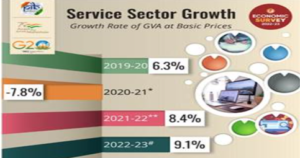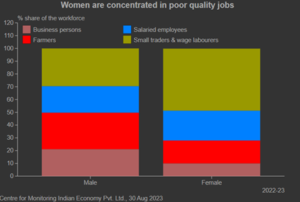“Addressing AI Job Displacement Concerns”.
Relevance:
- GS 3: Science and Technology- Developments and their Applications and Effects in Everyday Life.
- Tags: #AI #Employment #GS3 #IndianExpressEditorialAnalysis #UPSC #CMIE
Why in the News?
The employment landscape in India, as revealed by data from the Centre for Monitoring Indian Economy (CMIE), presents several thought-provoking trends and challenges, including shifts in age demographics, gender dynamics, and sectoral transformations.
India’s Pandemic-Induced Employment Crisis
- The COVID-19 pandemic posed one of the most significant employment challenges in India’s recent history.
- Analysis of data from the Centre for Monitoring Indian Economy (CMIE) highlights a concerning trend, where the total employed population declined from 412.7 million in 2016-17 to 387.2 million in 2020-21, followed by a partial recovery to 405.8 million in 2022-23.
CMIE Survey Uncovers Crucial Insights
First – Age-Related Employment Shifts in India (2016-2022)
- over the six years that concluded in 2022–2023, India’s employment decreased by -0.28% yearly compounded. Individuals older than 15 are included in this.
- The reduction was in the 15–39 age range, suggesting that younger workers left the workforce. From 50% to 37% of all jobs, their share decreased.
- On the other hand, the share of those aged 40 to 59 increased from 42% to 59%.
- Younger Indians struggled to find employment or simply choose to leave the workforce, whereas older Indians may have been affected by family obligations or debt repayment demands, which may have contributed to this age pattern.
Second – Decline in Female Workforce Participation
- Percentage of women in the workforce decreased from 13.1% to 9.4%.
- Some women may have quit their jobs due to family obligations.
- This represents a setback for gender equality.
Third – Education Stagnation Challenges Demographic Dividend
- Percentage of people with a graduate degree or higher remained constant at 12.5%.
- As a result, the majority of persons in employment have less education.
- This calls into doubt the idea of a demographic dividend when coupled with the fact that the proportion of workers under the age of 40 has decreased.
- Instead, if they are underqualified for jobs that offer a stable income, a youth bulge in a nation’s population might cause other socioeconomic problems.
- Making sure that people attend courses that are relevant to their intended careers should also be a priority.
- If they are not properly educated to begin with, even reskilling is difficult.
Fourth – Rise in Self-Employment Signals Economic Shift
- While the percentage of business owners climbed from 13% to 20%, the percentage of salaried workers has barely changed at roughly 21%.
- This suggests that more people are choosing to work for themselves instead of an employer when they get a job.
- This might be as a result of a growing entrepreneurial mindset or because businesses have been conservative in hiring more people.
- The demand for labor will decline more as more artificial intelligence (AI) and machine learning (ML) techniques are adopted, which is undesirable for a labor surplus economy.
Fifth – Darker Side of Economic Growth: Job Creation Lag in Urban Regions
- On the contrary ,from 42% in 2016–17 to 31% in 2017–18, the proportion of small businesses and wage labor declined.
- This reflects a reduction in employment at small and medium-sized businesses.
- In parallel, the percentage of farmers increased from 23.2% to 27.6%, demonstrating a reverse migration from India’s urban to rural areas.
- The darker side of our growth story is also revealed by this pattern, which confirms that job growth has not kept up with metropolitan areas’ economic expansion.
- There is little doubt that the high expense of living and the scarcity of affordable housing have contributed to this reverse flow.
Sixth – Dominance of the Services Sector: A 1.5% Annual Growth
- A breakdown of jobs by industry reveals that both agriculture and industry have seen negative growth, while only services have had positive growth, at a rate of 1.5% annually.
- At 36%, the share of services is practically identical to the share of agriculture. Industry, which made up 27% of employment in 2022–2023, is dominated by real estate and construction (mostly blue-collar jobs), with a 17.5% share, while manufacturing is lagging behind with 8.8%.
- Since employment is being created in this sector, there has been a rapid transition to services.
- Manufacturing has had a compounded yearly decline of 2% as a result of stagnant and slow growth.
Seventh – Retail’s Significant Contribution: The Backbone of Local Economies
- Commerce dominated the services sector with 17% of the 36% total share, with retail accounting for the majority of it.
- These would be the widely dispersed local kirana stores.
- Services for individuals and businesses, among others, experienced increase.
Eighth – Changing Religious Demographics in the Job Market
- Finally, CMIE data on employment across religions yields interesting observations, though being difficult to understand
- Hindu and Muslim representation declined. Nearly 96% of the population is comprised of them; the shares of Christians, Buddhists, and Jains all increased, while the shares of Sikhs remained stable.
- One possible contributing factor could be the preference of the latter group for service-oriented professions such as trading, which experienced a noticeable rise in both growth and market share.
Thought-Provoking Insight into Emerging Employment Trends
- The overall picture of employment based on CMIE statistics is undoubtedly thought provoking.
- Based on the methodologies utilized, we will continue to debate whether or not jobs are being generated, but this specific study throws some light on recent developments.
- In light of the demographic dividend, which is frequently hailed as an economic boon, weak employment among younger age groups is concerning. Also concerning is the fact that women are leaving the employment.
- The frequently advocated hypothesis of urban migration is at contrast with the return to farmland.
- Given the widespread belief that factories will be the source of future employment, the fact that manufacturing is not a major contributor to employment is revealing.
In light of these discoveries, a serious discussion is required to determine if further Artificial Intelligence (AI) and Machine Learning (ML) adoption is appropriate given our demands, even though we cannot escape it. How will jobs be produced in that case? Apart from that, making AI and ML as ethical and moral tool to cater the requirement of human is the need of the hour.
Source: Livemint, PIB.
Mains Question
Examine the broader significance of the CMIE employment data for India and elaborate on the necessity for a comprehensive national employment strategy for addressing changing job market dynamics and ensuring inclusive growth.





